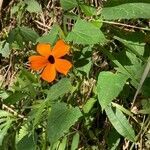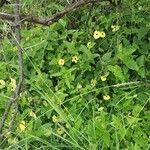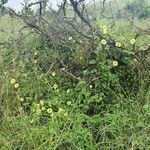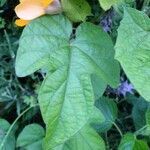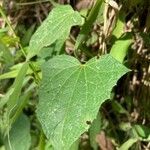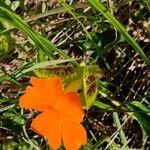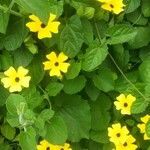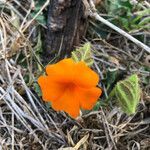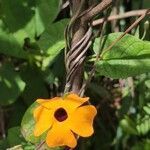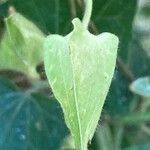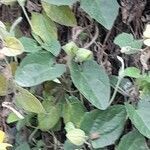Vines, herbaceous. Stems ± 4-angled to flattened, bisulcate, pubescent. Petiole 1.5-3 cm, winged, sparsely pubescent; leaf blade sagittate to deltoid ovate, 2-7.5 × 2-6 cm, abaxially hirsute, adaxially sparsely strigose, palmately 5-veined, base hastate to cordate, margin entire or undulate, apex acute. Flowers axillary, solitary; peduncle 2.5-3 cm, sparsely strigose; bracteoles ovate, 1.5-1.8 × 1-1.4 cm, abaxially hirsute, 5-7-veined, apex acute, acuminate, or obtuse. Calyx annular, unequally 10-13-lobed. Corolla orange with dark purple glandular "eye" in throat, 2.5-4.5 cm; tube basally cylindric for 2-4 mm, throat 1-1.5 cm; lobes obovate, apically truncate. Staminal filaments ca. 4 mm, glabrous; anther thecae 3.5-4 mm, unequal, pubescent at margin and base. Ovary glabrous; style ca. 8 mm, glabrous; stigma funnel-shaped, unequally 2-lobed, lower lobe spreading, upper lobe erect. Capsule pubescent, basal part ca. 7 × 10 mm, 2-seeded; beak ca. 1.4 cm, ca. 3 mm wide at base. Seeds reticulate on dorsal surface. Fl. Oct-Mar, fr. Feb-May. 2n = 18.
An evergreen twining climber. It keeps growing from year to year but is often grown as an annual plant. It grows 2.5 m high but is shorter if grown as an annual. The stems are slender, weak and twining. It winds to the right. The leaves are oval or triangular shaped with teeth along the edge. The are mid green colour. Leaves are 8 cm long with angular lobes at the base of the leaf. The leaf stalks have narrow wings. The flower has a long tube but spreads out at the top. The flowers are produced singly in the axils of the leaves. Many flowers are produced. Flowers are 3-4 cm across. They are usually bright orange-yellow. They can have a chocolate coloured centre. The petals can be white. Fruit are round 2-celled capsules. There can be 1-2 seeds in each cell. The seeds are irregularly ribbed on the back.
Herbaceous creeper; pubescent. Leaves petiolate, petioles (10-)22-50 mm long, winged; blade ovate (16-)21-43(-63) x (10-)17-32(-48) mm, apex acuminate, acute or obtuse, base cordate or hastate, margin entire or toothed. Flower bracts 13-19 x 10-16 mm. Calyx with sessile and stipitate glands. Corolla with inner and outer surface of lobes and outer surface of tube orange, inner surface of tube dark purplish black with white stripes at base; lobes 7.5-3.5 x 11-20 mm. Filaments 4-5.7 mm long; anther thecae 3.6-4.6 mm long. Style 8.5-11 mm long; stipitate glands present. Fruits 15-18 mm long, globose base 7.5-9 mm in diameter; stalk (13-)35-64 mm long. Seed brown; some trichomes adhere to form wing-like protuberances; 2.4-4 mm in diameter. T. alata flowers nearly the whole year round.
Herbaceous trailing or climbing vine with strigose hairs. Leaves deltoid to deltoid ovoid, 4.5-6.5 cm long, acute at the apex, the margins undulate, hastate to cordate at the base, the upper surface sparingly strigose, the lower surface hirsute; petioles winged, to 6.5 cm long. Inflorescences with the peduncles mostly longer than the petioles; bracts deltoid ovate with acute tips, hirsute. Flowers with the corolla yellow or orange with dark purple eye 1.5-2.0 cm long. Capsule depressed globose with a stout, flattened, subulate beak ca. 1. cm long, hirsute.
Herbaceous creeper, pubescent, 0.2-1.8 m high. Corolla orange, inner surface of corolla tube dark purplish black. Flowering time all year. Seeds with trichomes adhering in wing-like protuberances.
Herb, creeper. Petioles winged. Fruit densely pubescent; seeds with trichomes adhering in wing-like protuberances. Flowers orange, inner surface of tube purplish black.
Pale to dark yellow flowers (sometimes white) usually red or dark purple in the throat.
A softly pubescent herbaceous twiner
